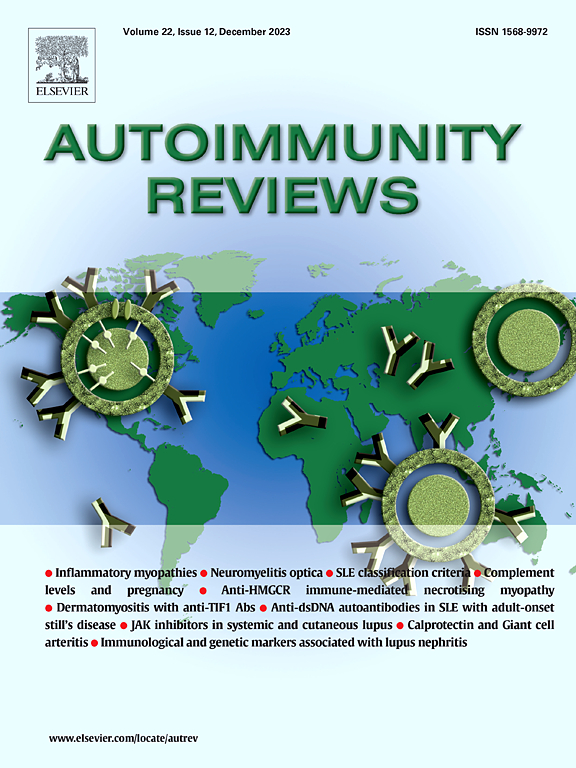系统性红斑狼疮以外的 A20 单倍体缺乏诊断:文献系统回顾。
IF 9.2
1区 医学
Q1 IMMUNOLOGY
引用次数: 0
摘要
系统性红斑狼疮(SLE)是一种自身免疫性疾病,其病理生理学尚不完全清楚,涉及遗传和表观遗传因素。然而,越来越多的一小部分患者出现单基因狼疮,这为该疾病的发病机制提供了新的见解。本系统综述的重点是与A20单倍功能不全(HA20)相关的SLE,这是一种与肿瘤坏死因子α诱导蛋白3基因(TNFAIP3)变异相关的单基因疾病。HA20除了主要表现为模仿behet病谱的自身炎症表型外,其一些临床和生物学表现也是自身免疫性疾病谱的一部分,包括肾小球肾炎以及频繁存在抗核抗体,有时具有抗dna特异性。在文献报道的191例HA20患者中,我们确定了16例患者(8.4% %)具有SLE的相容诊断。当可估计时,SLICC 2012和EULAR/ACR 2019分类标准的阳性率为92.9 %。大多数有多系统受累,主要是皮肤(81.3 %)、肌肉骨骼(56.3% %)和/或肾脏(56.3% %)表现。与其他SLE患者相比,他们似乎也表现出差异:发热、慢性皮肤红斑狼疮、口腔和生殖器溃疡、神经精神症状、自身免疫性细胞减少症和生物炎症标志物升高的患病率更高。这篇综述强调了在早发性疾病、家族史和/或提示自身炎症性疾病的特定临床表现的SLE患者中考虑TNFAIP3变异的必要性。认识到HA20-SLE患者可以提高我们对SLE发病机制的理解,并为这些患者提供更好的治疗策略。本文章由计算机程序翻译,如有差异,请以英文原文为准。
A20 haploinsufficiency diagnosis beyond systemic lupus erythematosus: A systematic review of the literature
Systemic lupus erythematosus (SLE) is an autoimmune disease whose pathophysiology remains incompletely understood, involving genetic and epigenetic factors. However, an increasing small subset of patients present with monogenic lupus, providing insight into the pathogenesis of the disease. This systematic review focuses on SLE associated with A20 haploinsufficiency (HA20), a monogenic disorder associated with tumor necrosis factor alpha-induced protein 3 gene (TNFAIP3) variants. Besides the mainly auto-inflammatory phenotypic expression of HA20 mimicking Behçet's disease spectrum, some of its clinical and biological manifestations are part of the spectrum of autoimmune diseases, including glomerulonephritis as well as the frequent presence of antinuclear antibodies, sometimes with anti-DNA specificity. Among all the 191 HA20 patients reported in the literature, we identified 16 patients (8.4 %) with a compatible diagnosis of SLE. When estimable, the SLICC 2012 and EULAR/ACR 2019 classification criteria were positive for 92.9 % of them. A majority had multi-system involvement, mainly cutaneous (81.3 %), musculoskeletal (56.3 %), and/or renal (56.3 %) manifestations. They also seemed to exhibit differences compared to other SLE patients: higher prevalence of fever, chronic cutaneous lupus erythematosus, oral and genital ulcers, neuropsychiatric manifestations, autoimmune cytopenia, and elevated biologic inflammatory markers. This review highlights the necessity of considering TNFAIP3 variants in SLE patients with early-onset disease, familial history, and/or specific clinical manifestations suggestive of autoinflammatory diseases. Recognizing HA20-SLE patients may improve our understanding of SLE pathogenesis and lead to better therapeutic strategies for these patients.
求助全文
通过发布文献求助,成功后即可免费获取论文全文。
去求助
来源期刊

Autoimmunity reviews
医学-免疫学
CiteScore
24.70
自引率
4.40%
发文量
164
审稿时长
21 days
期刊介绍:
Autoimmunity Reviews is a publication that features up-to-date, structured reviews on various topics in the field of autoimmunity. These reviews are written by renowned experts and include demonstrative illustrations and tables. Each article will have a clear "take-home" message for readers.
The selection of articles is primarily done by the Editors-in-Chief, based on recommendations from the international Editorial Board. The topics covered in the articles span all areas of autoimmunology, aiming to bridge the gap between basic and clinical sciences.
In terms of content, the contributions in basic sciences delve into the pathophysiology and mechanisms of autoimmune disorders, as well as genomics and proteomics. On the other hand, clinical contributions focus on diseases related to autoimmunity, novel therapies, and clinical associations.
Autoimmunity Reviews is internationally recognized, and its articles are indexed and abstracted in prestigious databases such as PubMed/Medline, Science Citation Index Expanded, Biosciences Information Services, and Chemical Abstracts.
 求助内容:
求助内容: 应助结果提醒方式:
应助结果提醒方式:


